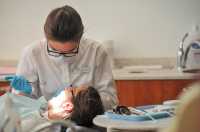
05 Nov Study Supports Antibiotic Prophylaxis Before Dental Procedures in High Risk Patients
MedicalResearch.com Interview with:

Prof. Thornhill
Martin H. Thornhill MBBS, BDS, PhD, MSc, FDSRCS(Edin), FDSRCSI, FDSRCS(Eng)
Professor of Translational Research in Dentistry
Academic Unit of Oral & Maxillofacial Medicine Surgery & Pathology,
University of Sheffield School of Clinical Dentistry
MedicalResearch.com: What is the background for this study?
Response: Infective endocarditis is an infection of the heart valves that has a high death rate (around 30% in the first year). It requires intensive treatment often involving replacement of affected heart valves and frequently results in serious long-term illness and disability in those who survive as well as an increased risk of re-infection and high healthcare costs.
In ~40% of cases, bacteria from the mouth are implicated as the causal organism. Because of this, guideline committees around the world recommended that all those at risk of infective endocarditis should receive antibiotic prophylaxis before undergoing invasive dental procedures. Due to a lack of evidence for efficacy, however, guideline committees started to limit the use of antibiotic prophylaxis. And in 2007, the American Heart Association (AHA) guideline committee recommended that antibiotic prophylaxis should continue for those at high-risk but should cease for those at moderate risk of endocarditis. Most guideline countries around the world followed suite. Except in the UK, where the National Institute for Health and Care Excellence (NICE) recommended that the use of antibiotic prophylaxis should completely stop in 2008.
MedicalResearch.com: What are the main findings?
Response: This study investigated antibiotic prophylaxis prescribing and incidence of infective endocarditis in a large population of Americans. Following introduction of the 2007 AHA recommendations, it found a large fall in antibiotic prophylaxis prescribing in those at moderate-risk and a smaller but still significant fall in those at high-risk of endocarditis.
In parallel, there was a highly significant increase in infective endocarditis in those at high-risk and a much smaller, barely significant, increase in those at moderate-risk.
MedicalResearch.com: What should readers take away from your report?
Response: While not proof that antibiotic prophylaxis prevents infective endocarditis, these findings are highly supportive of the AHA recommendation that those at high-risk of endocarditis should receive antibiotic prophylaxis before undergoing invasive dental procedures.
In addition, they provide evidence that NICE’s recommendation to withhold antibiotic prophylaxis from those at high-risk of infective endocarditis in the UK could be wrong and might leads to cases of infective endocarditis that could otherwise be prevented.
Citation: AHA/JACC
Antibiotic Prophylaxis and Incidence of Endocarditis Before and After the 2007 AHA Recommendations
Available Online 05 November 2018
https://doi.org/10.1016/j.jacc.2018.08.2178 JACC November 5 2018
[wysija_form id=”3″]
[last-modified]
The information on MedicalResearch.com is provided for educational purposes only, and is in no way intended to diagnose, cure, or treat any medical or other condition. Always seek the advice of your physician or other qualified health and ask your doctor any questions you may have regarding a medical condition. In addition to all other limitations and disclaimers in this agreement, service provider and its third party providers disclaim any liability or loss in connection with the content provided on this website.
Last Updated on November 5, 2018 by Marie Benz MD FAAD
